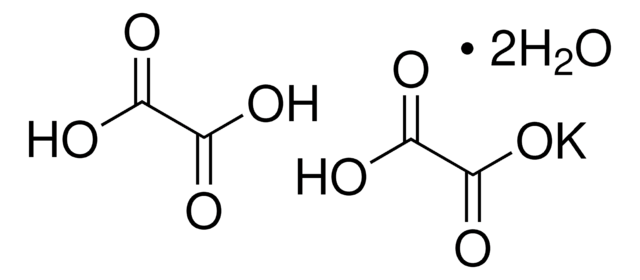1.01961
Potassium tetraoxalate dihydrate
certified secondary standard reference material for pH measurement; directly traceable to primary reference material from NIST/PTB pH (S) = 1.67₉ (25°C) Certipur®
Sinónimos:
Potassium tetraoxalate dihydrate, Oxalic acid hemipotassium salt, Potassium hydrogen oxalate-oxalic acid-water (1/1/2)
About This Item
Productos recomendados
grade
certified reference material
Quality Level
agency
complies with DIN 19266
product line
Certipur®
pH
1.7 (25 °C, 12.6 g/L in H2O)
solubility
25 g/L
density
1.84 g/cm3 at 20 °C
bulk density
860 kg/m3
application(s)
environmental
food and beverages
general analytical
industrial qc
pharmaceutical
format
neat
storage temp.
15-25°C
InChI
1S/2C2H2O4.K/c2*3-1(4)2(5)6;/h2*(H,3,4)(H,5,6);/q;;+1/p-1
InChI key
GANDVAJEIJXBQJ-UHFFFAOYSA-M
Categorías relacionadas
General description
Download your certificate at http://www.sigma-aldrich.com to view certified values, including uncertainty and expiry date.
Application
Features and Benefits
- The product is delivered with a comprehensive, batch-specific Certificate of Analysis showing the relevant data for the quality management system.
- The pH value of this Certipur® buffer solution is qualified using differential potentiometry with two platinum hydrogen electrodes against NIST & PTB primary reference materials [pH (S) = 1.679 (25 °C)].
- This buffer standard has a guaranteed shelf life of 4 years.
- Potassium tetraoxalate dihydrate buffer is a Certified Reference Material (CRM) offered in neat format. Solution of this standard is prepared in-house following instructions in European Pharmacopoeia (Ph. Eur. 2.2.3).
- Intended for extremely precise calibration, qualification and monitoring of pH instruments and routine assessment of their performance.
Analysis Note
Legal Information
signalword
Warning
hcodes
Hazard Classifications
Acute Tox. 4 Dermal - Acute Tox. 4 Oral - Eye Irrit. 2
Storage Class
11 - Combustible Solids
wgk_germany
WGK 1
Certificados de análisis (COA)
Busque Certificados de análisis (COA) introduciendo el número de lote del producto. Los números de lote se encuentran en la etiqueta del producto después de las palabras «Lot» o «Batch»
¿Ya tiene este producto?
Encuentre la documentación para los productos que ha comprado recientemente en la Biblioteca de documentos.
Nuestro equipo de científicos tiene experiencia en todas las áreas de investigación: Ciencias de la vida, Ciencia de los materiales, Síntesis química, Cromatografía, Analítica y muchas otras.
Póngase en contacto con el Servicio técnico








